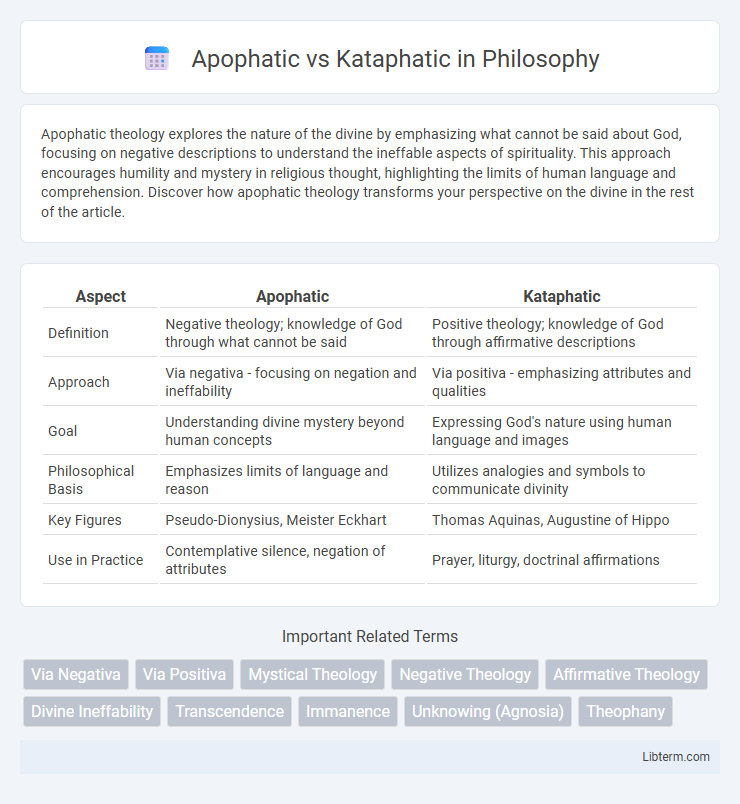Apophatic theology explores the nature of the divine by emphasizing what cannot be said about God, focusing on negative descriptions to understand the ineffable aspects of spirituality. This approach encourages humility and mystery in religious thought, highlighting the limits of human language and comprehension. Discover how apophatic theology transforms your perspective on the divine in the rest of the article.
Table of Comparison
| Aspect | Apophatic | Kataphatic |
|---|---|---|
| Definition | Negative theology; knowledge of God through what cannot be said | Positive theology; knowledge of God through affirmative descriptions |
| Approach | Via negativa - focusing on negation and ineffability | Via positiva - emphasizing attributes and qualities |
| Goal | Understanding divine mystery beyond human concepts | Expressing God's nature using human language and images |
| Philosophical Basis | Emphasizes limits of language and reason | Utilizes analogies and symbols to communicate divinity |
| Key Figures | Pseudo-Dionysius, Meister Eckhart | Thomas Aquinas, Augustine of Hippo |
| Use in Practice | Contemplative silence, negation of attributes | Prayer, liturgy, doctrinal affirmations |
Understanding Apophatic and Kataphatic Theology
Apophatic theology emphasizes understanding God through negation, highlighting what cannot be said or known about the divine essence, thus fostering a mystical experience beyond human comprehension. Kataphatic theology, in contrast, uses affirmative statements and positive descriptions to express God's nature, relying on scripture, tradition, and analogy. Both approaches are critical in Christian theological discourse, offering complementary ways to explore the transcendent mystery of God.
Historical Origins of Apophatic and Kataphatic Approaches
The historical origins of Apophatic and Kataphatic theology trace back to early Christian mysticism and Neoplatonism, where Apophatic theology emerged from the negative theology tradition, emphasizing God's unknowability by describing what God is not. Kataphatic theology developed concurrently, rooted in the affirmative tradition, focusing on knowing God through positive attributes and imagery derived from scripture and doctrine. Both approaches were systematized by Church Fathers like Pseudo-Dionysius the Areopagite, who balanced these methods in the 5th and 6th centuries to deepen theological understanding.
Core Principles of Apophatic Spirituality
Apophatic spirituality centers on the core principle of negation, emphasizing the ineffability of the divine by describing God through what cannot be said or known, fostering a direct experience beyond human concepts. It advocates for a path of silence, contemplation, and unknowing, where spiritual progress occurs by emptying the mind of preconceived images and affirmations. This approach contrasts with kataphatic spirituality, which utilizes positive affirmations and imagery to understand the divine, while apophatic seeks transcendence through mystery and paradox.
Defining the Kataphatic Method
The kataphatic method emphasizes positive affirmations to describe the divine or ultimate reality through attributes, images, and metaphors, aiming to reveal what God or the sacred is. It relies on direct language and concrete descriptions, asserting qualities such as omniscience, omnipotence, and benevolence. This approach contrasts with apophatic theology, which defines the divine by negation and what it is not, highlighting the kataphatic method's focus on affirmative, experiential knowledge.
Key Figures and Texts in Apophatic Thought
Key figures in apophatic thought include Pseudo-Dionysius the Areopagite, whose works such as "The Mystical Theology" emphasize the via negativa approach to understanding the divine by negation. Gregory of Nyssa contributed significantly with his texts like "On Not Three Gods," advocating for the unknowability of God's essence. Maximus the Confessor advanced apophatic theology through his synthesis of Greek patristic thought, underscoring the distinction between God's essence and energies.
Influential Contributors to Kataphatic Theology
Gregory of Nyssa and Thomas Aquinas stand as influential contributors to kataphatic theology, emphasizing positive affirmations about God's nature through scripture and reason. Aquinas' synthesis of Aristotelian philosophy with Christian doctrine established a framework for understanding God's attributes in a rational and accessible manner. Gregory of Nyssa's mystical writings further shaped kataphatic approaches by exploring divine qualities as knowable realities that can be positively described and contemplated.
Apophatic vs Kataphatic: Primary Differences
Apophatic theology emphasizes describing the divine by negation, asserting what God is not, while Kataphatic theology affirms God's nature through positive attributes and descriptions. Apophatic methods highlight the ineffability and transcendence of God, avoiding definitive language, whereas Kataphatic approaches use symbolic and metaphorical terms to express divine qualities. The primary difference lies in Apophatic theology's focus on the limits of human language versus Kataphatic theology's reliance on affirming knowledge about the divine.
Complementarity and Tensions Between the Paths
Apophatic and Kataphatic theology represent complementary yet tension-filled approaches to understanding the divine, where Apophatic emphasizes the ineffability and transcendent nature of God by negation, while Kataphatic employs positive affirmations and imagery to describe the divine attributes. This dynamic interplay highlights the limitations and strengths of each path, as Apophatic theology warns against idolatry of concepts, and Kataphatic theology fosters relational intimacy through concrete language. The tension arises from their differing epistemologies, yet their integration offers a holistic framework that enriches spiritual experience by balancing mystery and knowledge.
Apophatic and Kataphatic Practices in Modern Spirituality
Apophatic and Kataphatic practices in modern spirituality offer contrasting approaches to experiencing the divine, where Apophatic practices emphasize silence, negation, and the removal of concepts to encounter an ineffable God beyond words. Kataphatic practices focus on affirmations, imagery, and positive descriptions to build a personal and relational understanding of the divine presence. Contemporary spiritual traditions often integrate Apophatic meditation and contemplative prayer with Kataphatic visualization and devotional rituals to balance transcendence and immanence in the spiritual journey.
Implications for Contemporary Faith and Experience
Apophatic theology emphasizes God's ineffability and transcends human comprehension, fostering a spiritual humility that shapes contemporary faith by encouraging believers to embrace mystery and silence in divine experience. Kataphatic theology, by contrast, utilizes positive affirmations and imagery to describe God, providing a more accessible framework for worship and personal connection in modern religious practice. The interplay between apophatic and kataphatic approaches enriches contemporary spirituality by balancing transcendence with immanence, influencing liturgy, meditation, and theological discourse.
Apophatic Infographic

 libterm.com
libterm.com